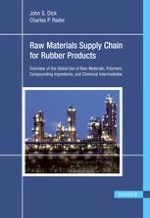2014 | Buch
Raw Materials Supply Chain for Rubber Products
Overview of the Global Use of Raw Materials, Polymers, Compounding Ingredients, and Chemical Intermediates
verfasst von: John S. Dick, Charles P. Rader
Verlag: Carl Hanser Verlag GmbH & Co. KG
